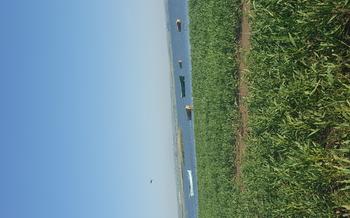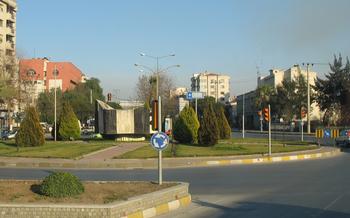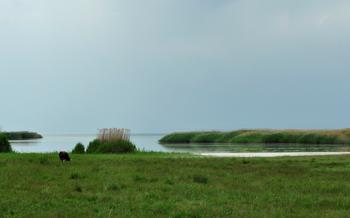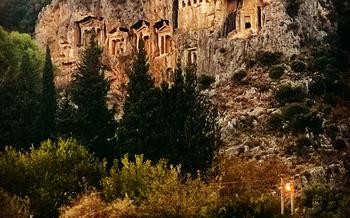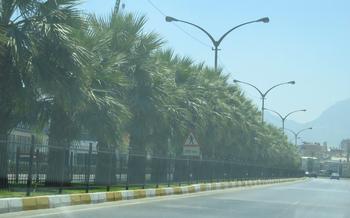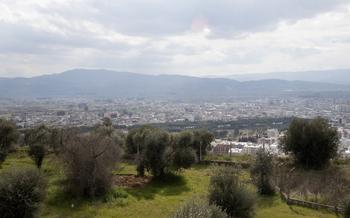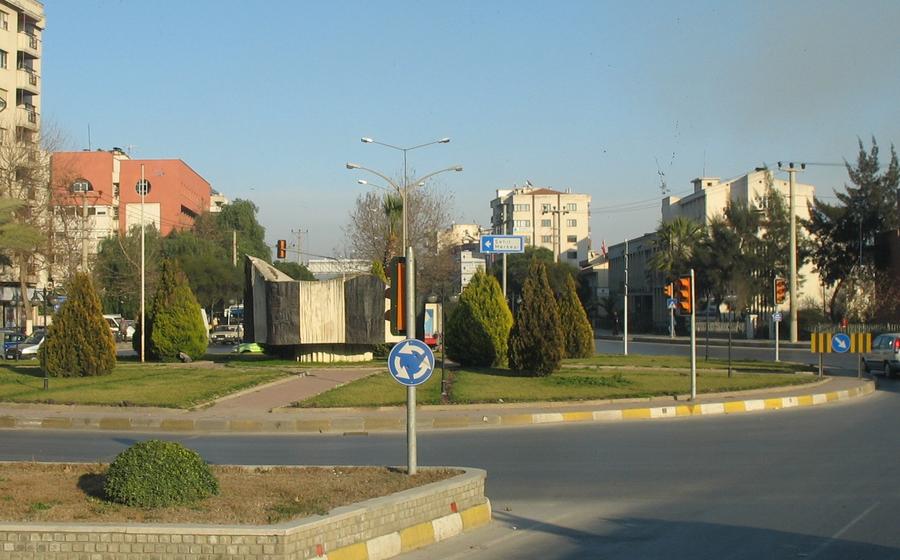
Menderes River Delta Bird Sanctuary
- Menderes River Delta: A Haven for Birders and Nature Enthusiasts
- Getting to the Menderes River Delta Bird Sanctuary
- Convenient Transportation Options
- Directions from Aydın
- Distance from City Center
- Guided Tours Availability
- Best Time to Visit the Menderes River Delta Bird Sanctuary
- What to Expect at the Menderes River Delta Bird Sanctuary
- Exploring the Different Habitats of the Menderes River Delta
- Unveiling the Rich Birdlife of the Menderes River Delta
- Tips for Birdwatching at the Menderes River Delta Bird Sanctuary
- Other Wildlife at the Menderes River Delta Bird Sanctuary
- Conservation Efforts at the Menderes River Delta Bird Sanctuary
- Things to Do in the Vicinity of the Menderes River Delta Bird Sanctuary
- Accommodation Options Near the Menderes River Delta Bird Sanctuary
- Planning Your Trip to the Menderes River Delta Bird Sanctuary
- Accessibility for Visitors with Disabilities
- Local Customs and Etiquette
- Insider Tip: Hidden Gems of the Menderes River Delta Bird Sanctuary
Menderes River Delta: A Haven for Birders and Nature Enthusiasts
In the heart of Turkey's enchanting Aegean region, the Menderes River Delta Bird Sanctuary stands as a captivating natural wonder, inviting birdwatchers and nature enthusiasts to immerse themselves in a world of unparalleled beauty and biodiversity. This unique ecosystem, recognized as a Ramsar site of international importance, boasts a rich mosaic of habitats, from shimmering salt marshes to lush reedbeds and tranquil riverine forests.
The Menderes River Delta is renowned for its exceptional birdlife, hosting a staggering array of both resident and migratory species. From the elegant flamingos that grace the wetlands to the soaring eagles that patrol the skies, the sanctuary provides a haven for birds of all kinds. This diverse avian community, coupled with the stunning landscapes that form the backdrop of the sanctuary, creates a truly unforgettable experience for visitors.
Getting to the Menderes River Delta Bird Sanctuary
The Menderes River Delta Bird Sanctuary is conveniently accessible from the city of Aydın. Whether you choose to drive or embark on a guided tour, the journey to this natural haven is both scenic and straightforward.
Convenient Transportation Options
By Car: For those who prefer the flexibility of self-guided exploration, renting a car is an excellent option. From Aydın, simply follow the signs towards the town of Söke, and then continue along the coastal road until you reach the bird sanctuary. The drive takes approximately 45 minutes and offers breathtaking views of the surrounding countryside.
By Guided Tour: If you prefer the convenience of a guided experience, several tour operators in Aydın offer birdwatching tours to the Menderes River Delta. These tours typically include transportation, a knowledgeable guide, and binoculars or spotting scopes for birdwatching.
Directions from Aydın
From Aydın, follow the D550 highway towards Söke. After approximately 30 kilometers, turn left onto the D555 road, which leads directly to the Menderes River Delta Bird Sanctuary. The entrance to the bird sanctuary is well-marked, and there is ample parking available.
Distance from City Center
The Menderes River Delta Bird Sanctuary is located approximately 45 kilometers from the city center of Aydın. The drive takes about 45 minutes, depending on traffic conditions.
Guided Tours Availability
Guided tours of the Menderes River Delta Bird Sanctuary are available through local tour operators in Aydın. These tours typically include transportation to and from the sanctuary, the services of an experienced birdwatching guide, and the use of binoculars or spotting scopes. Guided tours are a great option for those who want to learn more about the birds and the ecosystem of the sanctuary.
Best Time to Visit the Menderes River Delta Bird Sanctuary
The Menderes River Delta Bird Sanctuary offers a diverse range of birdwatching experiences throughout the year. However, the ideal seasons for birdwatching are spring (April-May) and autumn (September-October). During these periods, the sanctuary teems with migratory birds that stop over to rest and feed before continuing their journeys.
The spring migration brings a surge of colorful songbirds, such as nightingales, orioles, and bee-eaters, to the delta. This is also the time when many raptors, including marsh harriers and honey buzzards, can be spotted soaring overhead.
In the autumn, the sanctuary transforms into a haven for waterfowl, such as ducks, geese, and cranes. These birds descend on the delta in large numbers to escape the harsh winter conditions in their northern breeding grounds.
The winter months (November-March) offer a chance to observe resident bird species, such as great crested grebes, Pygmy cormorants, and Eurasian sparrowhawks. The sanctuary also attracts a number of wintering waterfowl, such as gadwalls and teals.
No matter what time of year you visit, the Menderes River Delta Bird Sanctuary offers a rich and rewarding birdwatching experience. The ever-changing seasons bring new and exciting species to the delta, ensuring that there is always something new to discover.
What to Expect at the Menderes River Delta Bird Sanctuary
The Menderes River Delta Bird Sanctuary offers a range of experiences for bird enthusiasts and nature lovers alike. With its diverse habitats, the sanctuary provides ample opportunities for birdwatching and wildlife observation.
Scattered throughout the sanctuary are observation towers strategically positioned to offer panoramic views of the surrounding landscapes and wetland habitats. These towers provide an elevated perspective, allowing visitors to scan the vast expanse of the delta and spot birds from a distance.
Guided tours are available for those who wish to delve deeper into the sanctuary's unique ecosystem. Led by experienced birdwatching guides, these tours provide insights into the birdlife, habitats, and conservation efforts undertaken at the sanctuary. The guides are knowledgeable about the bird species and can assist in identifying and observing them.
The sanctuary is a haven for photography enthusiasts, who can capture stunning images of the diverse birdlife and the picturesque landscapes. The variety of habitats and the abundance of bird species offer ample opportunities for capturing unique and memorable shots.
Exploring the Different Habitats of the Menderes River Delta
The Menderes River Delta boasts a diverse array of habitats, each offering unique opportunities for birdwatching. From the vast expanse of salt marshes to the tranquil waters of the riverine forests, every corner of the sanctuary promises a different experience.
Salt Marshes:
The salt marshes are a critical habitat for a variety of bird species, including the elegant avocet and the black-winged stilt. These wading birds probe the shallow waters in search of food, their long legs perfectly adapted to the soft, muddy terrain. The salt marshes also provide a haven for several species of gulls and terns, which can be seen wheeling and diving over the water.
Mudflats:
The mudflats, exposed during low tide, are a magnet for shorebirds. These long-legged birds, such as the curlew and the whimbrel, feed on the rich invertebrate life found in the mud. The mudflats also attract large numbers of gulls and terns, which scavenge for food scraps left behind by the receding tide.
Reedbeds:
The reedbeds, with their dense stands of reeds and rushes, offer shelter and nesting sites for a variety of bird species. The melodious song of the reed warbler fills the air, while the secretive bittern can be seen emerging from the reeds to feed in the shallow waters. The reedbeds are also home to several species of raptors, including the marsh harrier and the Montagu's harrier, which can be seen hunting over the reeds.
Riverine Forests:
The riverine forests, with their towering trees and dense undergrowth, provide a habitat for a variety of woodland bird species. The melodious song of the nightingale echoes through the forest, while the colorful hoopoe can be seen flitting among the trees. The riverine forests are also home to several species of woodpeckers, which can be heard drumming on the trunks of the trees.
Unveiling the Rich Birdlife of the Menderes River Delta
The Menderes River Delta Bird Sanctuary is a haven for birdlife, with over 300 species recorded, including resident and migratory birds. It serves as an important stopover site for migratory birds traveling between Europe, Asia, and Africa, making it a prime destination for birdwatching enthusiasts.
Among the resident bird species, visitors can spot the graceful white stork, the colorful hoopoe, and the melodious nightingale. The sanctuary is also home to several rare and endangered bird species, such as the globally threatened lesser kestrel and the near-threatened glossy ibis.
During the spring and fall migrations, the bird sanctuary comes alive with the arrival of a diverse array of migratory birds. Large flocks of flamingos, pelicans, and herons fill the skies, creating a spectacle that is sure to thrill any bird lover. Raptors such as eagles, hawks, and falcons can also be seen soaring overhead.
To enhance your birdwatching experience, consider bringing a pair of binoculars or a spotting scope to get a closer look at the birds. A birdwatching guide or joining a guided tour can also be beneficial, as they can help you identify and learn more about the different bird species.
Tips for Birdwatching at the Menderes River Delta Bird Sanctuary
To enhance your birdwatching experience at the Menderes River Delta Bird Sanctuary, consider these valuable tips:
Binoculars and Spotting Scopes: - Invest in a good pair of binoculars or a spotting scope to get closer views of the birds.
Clothing and Footwear: - Dress in layers to adapt to changing weather conditions. - Wear comfortable, sturdy footwear suitable for walking on uneven terrain.
Ethical Birdwatching: - Respect the birds' natural behavior and avoid disturbing them. - Keep a safe distance and use camouflage if necessary.
Patience and Perseverance: - Birdwatching requires patience and perseverance. - Be prepared to spend time quietly observing and waiting for birds to appear.
Other Wildlife at the Menderes River Delta Bird Sanctuary
In addition to its impressive birdlife, the Menderes River Delta Bird Sanctuary is home to a diverse array of other wildlife. Mammals, reptiles, and amphibians thrive in the sanctuary's various habitats. Otters, jackals, and wild boars roam the riverbanks and reedbeds, while turtles and frogs inhabit the marshes and ponds. Birdwatchers may also spot dragonflies, butterflies, and other insects flitting among the reeds and flowers.
The Menderes River Delta is also home to a variety of fish and invertebrates. The river's waters teem with carp, eels, and mullet, while the mudflats and salt marshes are home to a variety of crabs, shrimp, and mollusks. These creatures play a vital role in the ecosystem, providing food for birds and other wildlife.
The sanctuary's plant life is equally diverse, with a variety of trees, shrubs, and wildflowers growing throughout the area. Tamarix trees line the riverbanks, while reeds, rushes, and sedges dominate the marshes. In the spring, the delta is awash in color as wildflowers bloom in abundance, attracting bees, butterflies, and other pollinators.
Conservation Efforts at the Menderes River Delta Bird Sanctuary
The Menderes River Delta Bird Sanctuary is a vital haven for birdlife, and its conservation is of paramount importance. Several projects and initiatives are in place to protect and preserve this unique ecosystem.
One key aspect of conservation efforts is habitat protection. The sanctuary's diverse habitats, including salt marshes, mudflats, reedbeds, and riverine forests, are crucial for the survival of various bird species. Conservationists work to restore and maintain these habitats through measures such as vegetation management, invasive species control, and water level regulation.
Habitat creation is another important conservation strategy. Creating new habitats, such as nesting sites and feeding grounds, helps increase the carrying capacity of the sanctuary and supports a greater diversity of bird species.
Education and awareness are vital components of conservation efforts. Local communities and visitors are engaged through educational programs, workshops, and guided tours to foster an understanding of the sanctuary's importance and the need for its protection. Raising awareness helps create a sense of stewardship and encourages responsible behavior among visitors.
Monitoring and research play a crucial role in guiding conservation actions. Scientists and researchers conduct regular surveys and studies to assess bird populations, track migratory patterns, and identify threats to the sanctuary. This data informs conservation strategies and helps ensure that the sanctuary remains a safe and thriving habitat for birds.
Things to Do in the Vicinity of the Menderes River Delta Bird Sanctuary
Beyond the birdwatching haven, the vicinity of the Menderes River Delta offers a wealth of cultural and natural attractions. History buffs can delve into the ancient past at the nearby Ephesus ruins, a UNESCO World Heritage Site that boasts impressive Greco-Roman architecture and artifacts. The charming villages of Sirince and Camliyayla invite visitors to explore their cobblestone streets, traditional Ottoman houses, and local handicrafts.
For a taste of authentic Turkish cuisine, savor the flavors of fresh seafood at one of the many fish restaurants along the delta. Indulge in the region's olive oil, renowned for its distinct flavor and health benefits. Culinary enthusiasts can embark on a culinary adventure by visiting local markets, cooking classes, and olive oil tasting sessions.
Accommodation Options Near the Menderes River Delta Bird Sanctuary
When planning your trip to the Menderes River Delta Bird Sanctuary, you'll need to find a comfortable place to stay. Several accommodation options are available in the vicinity of the bird sanctuary, catering to different preferences and budgets.
For those seeking a luxurious and convenient stay, hotels and guesthouses offer a range of amenities, including comfortable rooms, private bathrooms, and often stunning views of the natural surroundings. These establishments provide a relaxing haven for birdwatchers after a long day of exploring the sanctuary.
If you prefer a more immersive experience, camping and caravan sites allow you to camp under the stars and wake up to the sounds of birdsong. These campsites offer basic facilities, such as toilets, showers, and designated camping areas, providing a rustic and adventurous stay.
For those seeking a unique and authentic experience, farm stays and agritourism offer a chance to immerse yourself in the local way of life. These accommodations provide a glimpse into Turkish rural culture, with opportunities to learn about farming practices, taste local cuisine, and enjoy the tranquility of the countryside.
No matter your preference, you'll find suitable accommodation options near the Menderes River Delta Bird Sanctuary to make your stay comfortable and enjoyable, allowing you to fully immerse yourself in the wonders of this natural paradise.
Planning Your Trip to the Menderes River Delta Bird Sanctuary
Suggested Itineraries: Choose from a range of itineraries to suit your interests and time constraints. For a comprehensive experience, opt for a 2-3 day trip, allowing ample time for birdwatching, exploring the sanctuary's habitats, and visiting nearby attractions.
Duration of Stay: Customize your stay based on your preferences. Consider spending at least one full day in the bird sanctuary to fully appreciate its diverse birdlife and landscapes. If time permits, extend your stay to explore the surrounding region, including historical sites and charming villages.
Budgeting Tips: Plan your budget wisely to make the most of your trip. Accommodation options vary from budget-friendly guesthouses to comfortable hotels. Consider self-catering options to save on dining expenses. Guided tours can be arranged for a fee, offering valuable insights into the sanctuary's birdlife and ecosystems.
Accessibility for Visitors with Disabilities
The Menderes River Delta Bird Sanctuary is committed to providing an accessible and inclusive environment for all visitors, including those with disabilities. Wheelchair-accessible trails and facilities are available throughout the sanctuary, ensuring that everyone can enjoy the beauty and wonders of the natural world. Visitors with special needs can request assistance from the friendly and knowledgeable staff, who are always ready to lend a helping hand.
Designated parking spaces for disabled visitors are located near the visitor center and observation towers. Restrooms and other facilities are also wheelchair-accessible, ensuring that everyone can comfortably explore the sanctuary. Visitors with visual impairments can take advantage of audio guides and tactile maps, which provide detailed information about the birdlife and habitats of the sanctuary.
The sanctuary's staff is dedicated to ensuring that all visitors have a positive and fulfilling experience. They are happy to provide assistance with birdwatching, transportation, and any other needs that visitors may have. With its accessible trails, facilities, and supportive staff, the Menderes River Delta Bird Sanctuary welcomes visitors of all abilities to come and experience the wonders of nature.
Local Customs and Etiquette
When visiting the Menderes River Delta Bird Sanctuary, it's crucial to be respectful of Turkish culture and traditions. Dressing modestly and behaving appropriately in public spaces is essential. When interacting with locals, a friendly smile and a warm greeting go a long way. It's also important to avoid topics that may be considered sensitive or controversial. By showing respect for local customs and etiquette, you can help preserve the unique charm and hospitality of the region.
Insider Tip: Hidden Gems of the Menderes River Delta Bird Sanctuary
Beyond the well-known observation towers and trails, the Menderes River Delta Bird Sanctuary holds hidden gems waiting to be discovered by adventurous bird enthusiasts. Venture off the beaten path to uncover secluded spots that offer unparalleled birdwatching experiences. Explore the labyrinthine channels and waterways by kayak or canoe, immersing yourself in the tranquil beauty of the delta. With a little luck and patience, you might encounter rare and elusive bird species that seldom grace the more popular areas. Keep an eye out for the shy and secretive bittern, the acrobatic marsh harrier, or the majestic osprey soaring overhead. Embrace the element of surprise as you navigate the hidden corners of this avian paradise, creating lasting memories of your time at the Menderes River Delta Bird Sanctuary.
